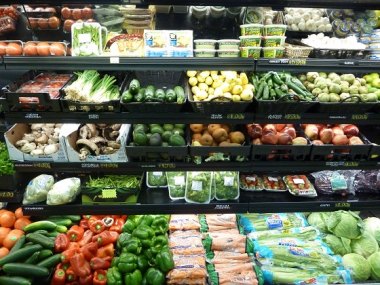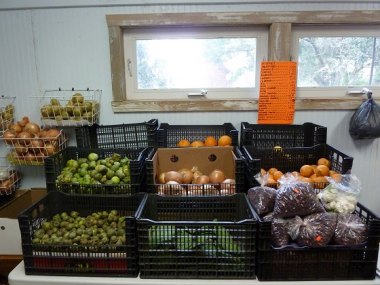You Are What You Eat
Most participants in a meeting to discuss food needs on Ocracoke said no organic produce was their greatest frustration. Others hope to see school and community gardens, and a community kitchen in the future. Marketing locally caught seafood is also an issue.
Restauranteurs, eaters, cooks, gardeners, and the merely curious turned up to learn and participate in the discussion, which was funded through Saltwater Connections.
Food systems are complex, said meeting facilitator Christy Shi, of the Center for Environmental Farming Systems. Limited distributors serve Ocracoke, and finding a greater variety of foods that are both accessible and affordable will take careful planning and work.
"If it was easy, it would already be done," said Shi, who shared her expertise and presented some options for islanders to explore.

Both working waterfronts and farmlands are falling away due to development, said Shi. Existing distribution channels often rely on huge corporations and industrial farms, presenting a challenge for those who want to eat a healthy, environmentally sustainable, and diverse diet in a remote town such as Ocracoke.
While small scale animal husbandry, mainly raising chickens, and gardening for the table are both increasing in popularity on Ocracoke, the island will always need to look elsewhere to fully support its food needs.
"You cannot do this alone on Ocracoke. You absolutely cannot," said Shi. Unless islanders want to depend upon a limited diet of seafood, game fowl, and seasonal produce, we must import food.
This earlier article in Ocracoke Current gives a sense of the cuisine that dominated island tables for most of its settled history. As this writer's grandfather, who was born on the island in 1901, once observed, "We were cold in the winter, hot in the summer, and ate fish three times a day." To me, the meeting seemed to say, Let's not romanticize the self-sustaining past too much, but plan for a sustainable future that involves us sharing our fresh catch (and figs!) in exchange for hormone free meats and dairy, and pesticide free produce.
Access to small, local farmers is one key issue islanders who want to eat "green," while still having the cake of variety, must address. There is a "very, very, very low profit margin in the food industry," said Shi. Can regional food be affordable and still add value all the way along the chain? she asked.
Even the Variety Store struggles to provide variety. Owner Tommy Hutchinson traveled to meet the Rich Foods truck at Conner's Market in Hatteras during the tourist season so he could offer organic produce. The investment in time and dollars often costs island stores more than it benefits them. While grocers want to meet the needs of customers, losing money is not a great business plan.
Offering organic and exotic fruits and vegetables is "hard to do, and it's expensive." Even stocking a reasonable selection of fresh product is challenging, given the small market, and the propensity of many to leave the island to shop. "He throws away a lot of produce," said employee Mandy Jones.
She and Trudy Austin then fondly recalled the delicious hybrid melons, somewhere between a pear and a cantaloupe, that they offered for a few weeks last summer. Rhubarb didn't sell especially well, said Trudy.
Bananas outsell all the other produce, and green onions are the runner-up, noted Variety Store cashier Debbie Jenkins. Staples like cauliflower, broccoli, onions, apples, citrus, carrots, mushrooms (both button and portabella!), cabbage, tomatoes, lettuce and peppers are regularly supplemented with seasonal offerings like asparagus, okra, brussel sprouts, and pears.

"Organic is hard to get, and so expensive," said Karla Ortiz, owner of La Isla grocery in Spencer's Market. She orders her produce through a store her family owns in Washington, NC, and her father delivers it every Friday. While she is open to the idea of selling organic fruits and vegetables, she's found no reliable supply her customers can afford.
Cactus, tangerines, jamaica (no, it's not jicama--go check it out!), tomatillos, potatoes, limes, onions, and a large selection of peppers, both fresh and dried, were available at La Isla on an early March day. Avocados and mangoes are far and away the most popular with her American customers, said Ortiz. "A lot of people will try new things if I tell them it's good," she said of her wares that are unfamiliar to cooks raised north of the border.
Educating consumers about how to prepare and serve unfamiliar produce, seafood, and meat products is crucial to viable markets, said Shi, as is finding creative, delicious ways to package and market parts of food that are often wasted. Scrapple, anyone?
Small, community run grocery stores are an asset, said Shi. Consumers can change what is available to them by communicating with the owners, and speaking with their shopping dollars.
For regional foods, Carteret County, which has several Community Supported Agriculture (CSA) farms, may provide a better solution than Hyde, which has only two farms that are not industrial, suggested Shi. Maintaining a steady supply of locally raised meats and produce can be difficult when dealing with small scale farmers. It requires multiple farms and coordination.
CSA farms typically ask for an upfront investment from buyers, to help spread the risk amongst consumers and farmers. Clients then receive produce harvested that week. The CSA model is increasingly being used by small scale fisheries, and called a CSF.
A CSA from Currituck has made weekly deliveries, and also sets up a produce stand, for the past several years. While participants and buyers are grateful for the option, not everyone is prepared to eat only what is in season, or prepared to preserve the abundance.
Networks to bring food from farm to table are starting to spring up around North Carolina. Fishermen could tap into existing smaller scale distributors to get their catch to markets in the densely populated triangle and triad regions, and the same trucks could deliver NC produce to the island, suggested Shi.
Because there are long distances between consumers and producers, "get creative to align pieces so it can be profitable. Ocracoke could fill some gaps if it works within existing channels," said Shi.
Catherine Mack has been calling Ocracoke her part time home since November, 2012. A former restauranteur and organic gardener, she will be working this season at Home Grown Hettie's, and has volunteered in the school courtyard garden over the winter. She is coordinating with CSA farmers in Carteret to bring produce on a refrigerated fish truck that already visits the island.
"I'd love to hear if people want a CSA format, or if they want a small CSA and the option to buy." Catherine envisions regional produce and CSA boxes being available at the Homegrown & Handmade market in the Community Square. She also sees potential to market the unsold produce as prepared foods that are easy to freeze, heat and serve (think quiche and frittata), or as preserves.
"I'm a huge fan of vegetables. I'm not a huge fan of driving long distances for shopping," said Catherine. Intensive urban gardening models could work well for Ocracoke. "Think food, not lawns," she said. Catherine encourages people to contact her at (828) 606-4528 or via email at catmccon@yahoo.ca. "I'm happy to talk to anyone."
Gary Mitchell suggested that a refrigerated storage space, possibly in the Community Store, where people could pick up CSA orders at their convenience, would encourage more islanders to participate.
Dairy is trickier to address, as most dairy farmers sell directly to a large system, which pasteurizes and packages milk, yogurt and cheese before it hits grocers shelves. (I was lucky enough to visit La Isla on a day last summer when handmade cheese, straight from Oaxaca, had arrived. It was not unlike a good fresh mozzarella. Ortiz said that supply is unreliable, but hopes to access it again in the future.)
"You miss opportunities or create barriers if you don't address all aspects of the food system," advised Shi. "Groceries, restaurants, and all the assets that matter in a small community" must be included in a "systems approach" to food production, consumption and distribution.
She suggested that restaurants could try offering daily or weekly "carbon cutting specials" based on seasonally available regional foods. That doesn't hurt the rest of the menu, and adds value for customers interested in local food.
Everybody should compost! added Shi, pointing to small communities that generate profits for their towns and counties by producing rich soil from compost, and also by separating their own recyclables.
Community kitchens require a significant investment, but serve as vital incubators for small and new businesses, said Shi.
This conversation is only just beginning, noted one participant. Plans are being made to identify the many aspects of the food system on Ocracoke, and everyone who eats is invited to contribute their thoughts.
The next meeting will be Saturday, March 9th at 4:00 p.m. in the Working Watermen's Exhibit (on the Community Store docks). The goal of this second meeting will be to appoint group leaders, add more ideas, prioritize, and walk away with a "To Do List."



